|
|
JAMES BOND
|
|
|
JAMES BOND
|
|
||||
|
||||
|
Part Two: The Raymond Hawkey covers On March 25, 1963, James Bond author Ian Fleming was invited to a lunch at London's White Tower restaurant on Percy Street in Bloomsbury, by Daily Express entertainment columnist Peter Evans. Also present were fellow author Len Deighton and a 33-year-old graphic designer named Raymond Hawkey. The half-page account of the historic meeting between the two authors appeared in the newspaper two days later. Ian Fleming had just returned from Jamaica where he had completed his penultimate James Bond novel YOU ONLY LIVE TWICE, and Raymond Hawkey (who was an art college friend of Deighton) had designed the stylish black & white cover for Deighton's debut novel The Ipcress File, first published in November 1962. Hawkey was then working at the Daily Express and had also provided graphic panels to accompany the newspaper's serialization of GOLDFINGER in 1959, RISICO (re-titled The Double-Take) in 1960, and THUNDERBALL in 1961. Hawkey later provided a similar page header for YOU ONLY LIVE TWICE, when the Daily Express serialized the novel in the fortnight before its hardback publication on March 16, 1964. |
||||
|
||||
|
With the release of the first James Bond film Dr. No in October 1962 there was naturally a renewed interest in the Ian Fleming novels, and PAN Books issued a paperback edition of DR. NO with a film tie-in cover which proved to be their biggest seller that year. The popularity of simple contemporary graphic designs pioneered by Raymond Hawkey prompted PAN Books to re-issue the Bond novels again to coincide with the first paperback publication of THUNDERBALL in May 1963. Hawkey was the natural choice to bring James Bond up-to-date, which was in stark contrast to the garish painted covers by Rex Archer, Sam Peffer and Pat Owen in the late 1950s. It was Dr. No's co-producer Harry Saltzman who was instrumental in getting Hawkey the prize job of redesigning the James Bond paperback covers. Saltzman had invited Len Deighton to Pinewood Studios in October 1962 just before the publication of The Ipcress File and the release of Dr. No, and over lunch told the author that he wanted to purchase the film rights. The stark contemporary design of the dust jacket for The Ipcress File made a strong impression on Saltzman and he persuaded Aubrey Forshaw, the chairman of PAN Books, to commission Raymond Hawkey to redesign the James Bond paperbacks. |
||||
|
||||
|
Hawkey proposed for the first time that ‘JAMES BOND’ should be elevated above the book title, and this be twice the size of the title and author's name. He originally intended that the typography be laid over a photograph of a well-muscled hairy chest. This proved too risqué and vaguely indecent, so it was decided to use a man's back on the final cover. The THUNDERBALL cover also broke new ground in that it had two .38 calibre bullet holes die-cut into Brian Duffy's cover photograph. Surrounding each bullet hole is a torn-paper effect, so it is not the man that has been shot, but the book itself - the two spent bullets are then seen on the opening page [ROLLOVER image below]. Ian Fleming saw the new design shortly after the meeting at the White Tower restaurant and on April 9, 1963, wrote a letter to Hawkey congratulating him on the new cover: “Thank you very much for the pulls of the really brilliant cover you have designed. I think it is quite splendid and I don't think the filthy little Pan sign spoils it too much”. |
||||
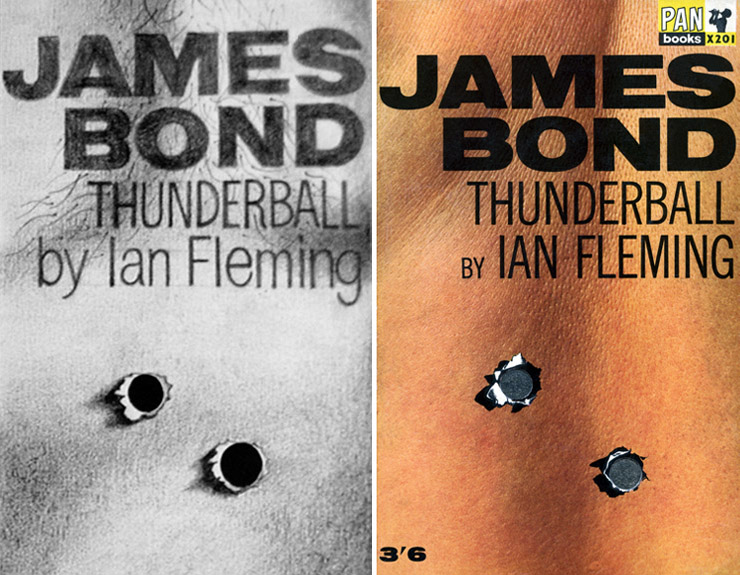 |
||||
|
With an initial print run of 350,000 copies (the largest of any James Bond paperback at that time), the PAN edition of THUNDERBALL was published on May 3, 1963, followed by CASINO ROYALE in June which had an initial print run of 100,000. Although Raymond Hawkey is only credited on the rear of the THUNDERBALL paperback, it is undeniably his designs which feature on the rest of the series. It is likely that PAN staff did the layouts for the rest of the covers which followed during the next four years. Raymond Hawkey later admitted that PAN Books were so pleased with the success of THUNDERBALL that the chairman sent his design fee twice, something that had never happened before nor since! THUNDERBALL sold a staggering 808,000 copies in its first six months on sale, and was reprinted eleven more times over the next two years before the Raymond Hawkey cover was superseded by the film tie-in paperback. In total PAN Books printed almost 1.7-million copies of THUNDERBALL with the Raymond Hawkey cover, making it by far the most popular title of this series. |
||||
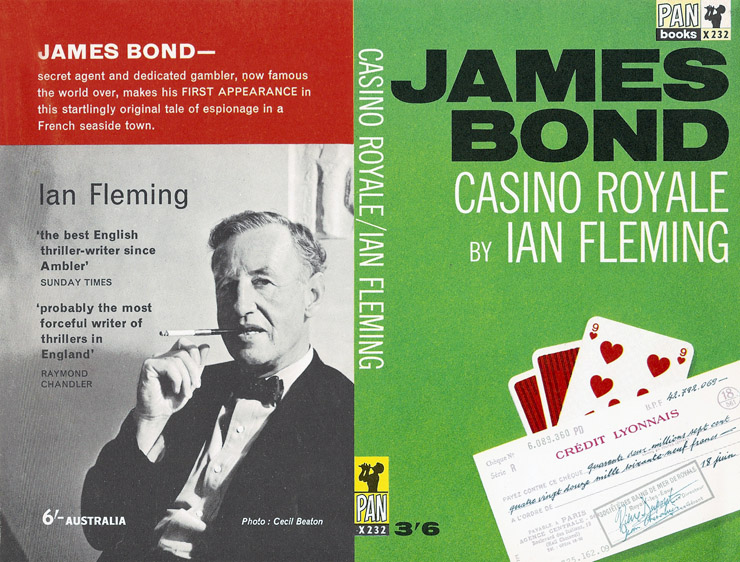 |
||||
|
In July 1963 LIVE AND LET DIE was re-issued with the Hawkey cover but had an initial print-run of just 15,000. Although this was the 11th printing, paperback sales of this title had only reached around 800,000. The following month saw GOLDFINGER, FOR YOUR EYES ONLY, MOONRAKER and DIAMONDS ARE FOREVER issued with new covers, each limited to an initial print-run of 120,000. However, sales were on the increase and no doubt boosted by the release of the second film From Russia With Love in October 1963. By the end of the year sales of the James Bond novels in paperback had reached a staggering 7.3-million copies; with 4.5-million sales in 1963 alone! The film tie-in version of DR. NO was still available as X237, and the film tie-in version of FROM RUSSIA, WITH LOVE (X236), with its glossy laminated wrap-around cover, also sold in huge quantities in 1963/64. The FROM RUSSIA, WITH LOVE film tie-in edition also featured a die-cut front cover with holes punched out to represent the sprockets of the 35mm film stock. |
||||
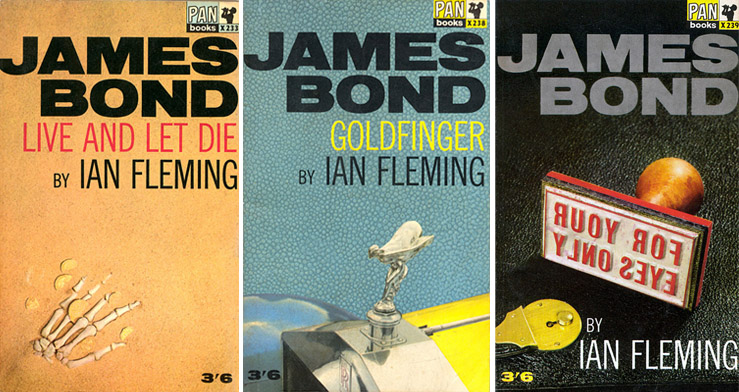 |
||||
|
In January 1964 FROM RUSSIA, WITH LOVE became the first James Bond novel to sell over a million copies (when the film tie-in cover was in circulation) and was only the sixth paperback (and fourth PAN title) in Great Britain to achieve this distinction. Within days of each other in May 1964 DR. NO, THUNDERBALL, CASINO ROYALE, LIVE AND LET DIE, MOONRAKER and DIAMONDS ARE FOREVER all passed the one-million milestone. |
||||
|
||||
|
||||
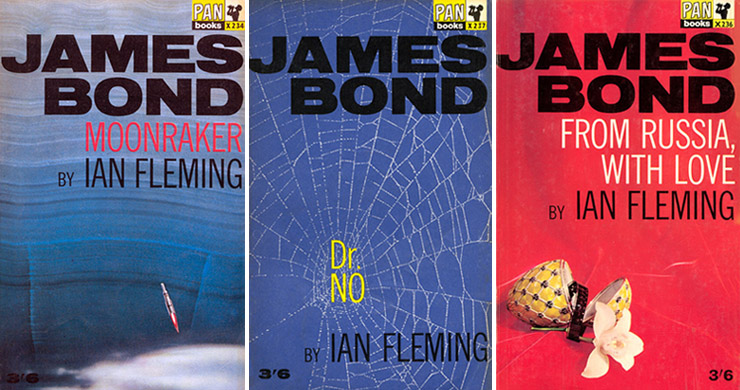 |
||||
|
||||
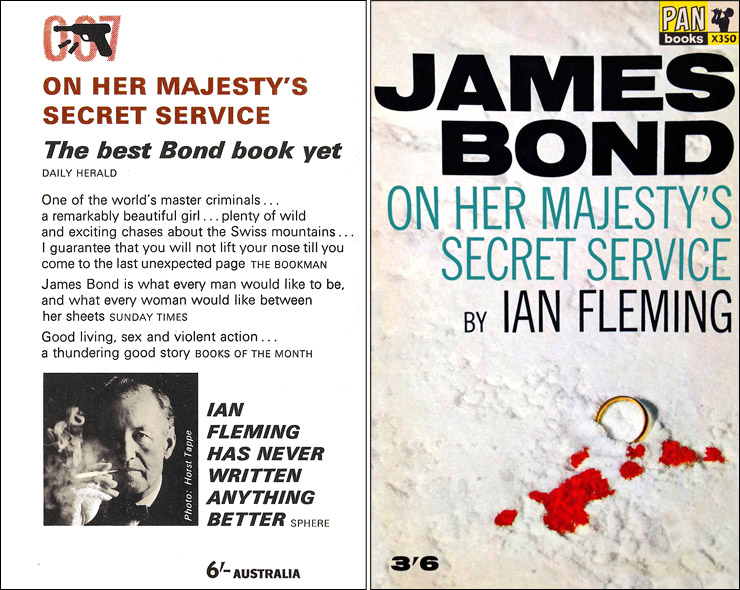 |
||||
|
The paperback edition of ON HER MAJESTY'S SECRET SERVICE was published by PAN Books in September of 1964, 18-months after the hardback edition from Jonathan Cape. With an initial print-run of 100,000 copies, the first three printings of the paperback were for export only, and it was not until the 4th printing on May 7, 1965, that the novel was widely available in the UK. Collectors should note that the first three printings had the title in blue, whereas from the 4th printing it was green. A variant version with the title in a reddish-brown colour is also known to exist. An example can be seen in the promotional TV film Welcome To Japan Mr. Bond (1967) [pictured at the bottom of the page]. Once available in the UK the paperback edition sold in huge numbers and was reprinted five times with the Raymond Hawkey cover. The fourth printing was the highest ever in the history of British paperback publishing, with a staggering one-million copies produced. |
||||
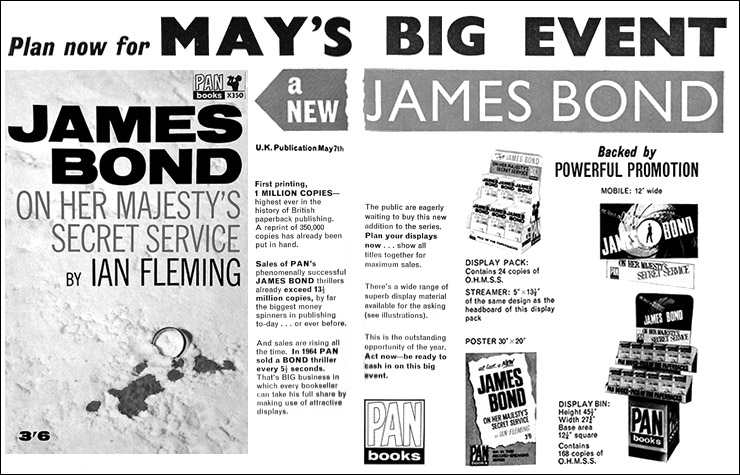 |
||||
|
It should also be noted that the rear cover of the original export editions of ON HER MAJESTY'S SECRET SERVICE had a photograph of Ian Fleming by Cecil Beaton, which was replaced with the Horst Tappe portrait on the later Home market printings. By the end of 1965 ON HER MAJESTY'S SECRET SERVICE had sold almost two-million copies; the highest annual total for any title, and over twice as many as its nearest rival THUNDERBALL. Overall sales of PAN James Bond paperbacks also peaked in 1965 and by the end of the year they had sold over six-and-a-half million copies in the UK alone! |
||||
|
||||
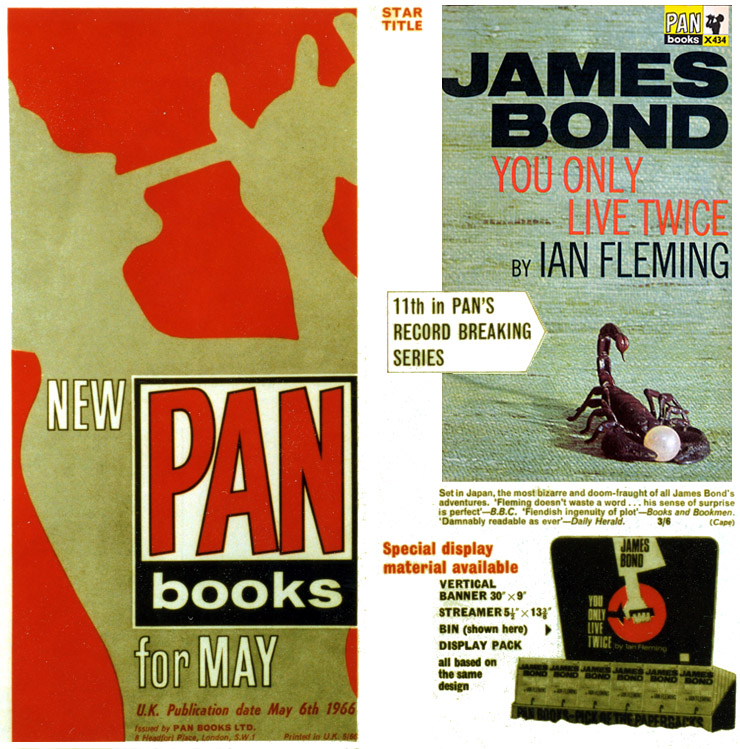 |
||||
|
YOU ONLY LIVE TWICE was first published in paperback by PAN in July 1965, but once again this edition was for export only and the cover has no price printed. 250,000 copies of this edition of the paperback were produced and the cover was laminated making it stand out from the rest of the series. The 2nd and 3rd printings reverted to the paler card cover and were the ones sold in the UK when the paperback was published on May 6, 1966. After just six weeks PAN Books reported that YOU ONLY LIVE TWICE has sold a total of 1.4-million copies. Although a later film tie-in edition was printed in 1967, some copies with the Hawkey cover can be found with a film tie-in wraparound jacket. This was created to use up old stock before the true film tie-in was printed, and are copies are now extremely hard to find. |
||||
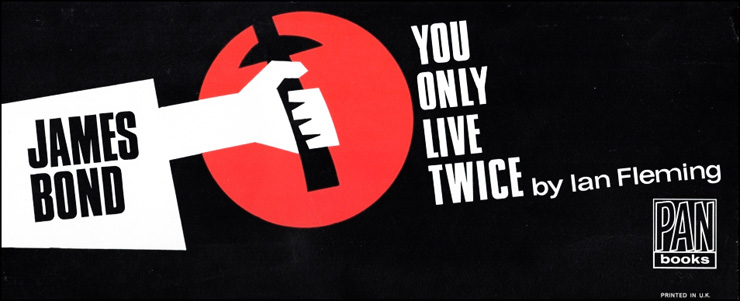 |
||||
|
The paperback edition of Ian Fleming's final novel THE MAN WITH THE GOLDEN GUN was first published by PAN in July 1966 with an initial print-run of 322,000 copies. This was the second-biggest selling title that year behind YOU ONLY LIVE TWICE, and had sold 273,000 copies by the end of 1966. However, the first edition of paperback edition of THE MAN WITH THE GOLDEN GUN had been exported to Commonwealth countries, and not available in the UK until May 12, 1967. THE MAN WITH THE GOLDEN GUN was reprinted four more times in 1967 with sales of 485,000, making it the second most popular of the James Bond novels sold by PAN that year, only beaten by THE SPY WHO LOVED ME which was making its UK paperback debut. |
||||
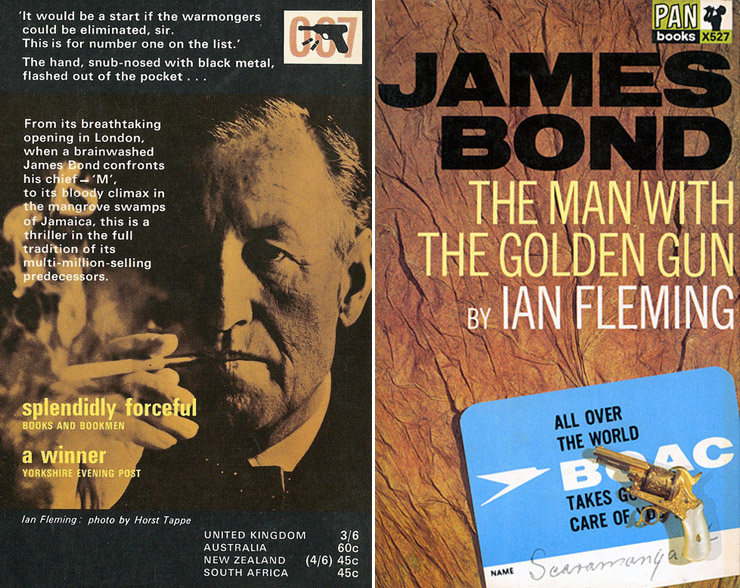 |
||||
|
Also appearing in paperback on December 2, 1966, was The Book of Bond (Or Every Man His Own 007) which had been published in hardback in May 1965 by Jonathan Cape, with a clever reversible dust-jacket once again devised by Raymond Hawkey. For the paperback edition Hawkey used a generic still-life montage of several items featured in Fleming's James Bond novels including Bond's gold-banded Morland & Co cigarettes and Walther PPK. A jar of Fortnum & Mason caviar and Dunlop Number 4 Golf Ball are not mentioned specifically in the novels, but no doubt the still-life montage idea formed the genesis for the series of covers which followed in the 1970s, although these were more meticulously researched to include the exact items Fleming describes in the relevant novels. Raymond Hawkey's concept artwork (displayed for the first time at the 2008 ‘Bond Bound’ exhibition at The Fleming Collection) showed the ideas taking shape. It's apparent that both non-fiction books were designed to fit in with the current series of Ian Fleming James Bond PAN paperbacks then in circulation throughout the UK and the Commonwealth. Published in hardback by Jonathan Cape in May 1965, The James Bond Dossier by Kinsley Amis then appeared as a PAN paperback on May 12, 1967, with a cover featuring the Raymond Hawkey designs seen on four of Ian Fleming's PAN paperbacks, including the recently published THE MAN WITH THE GOLDEN GUN; the rubber stamp used on FOR YOUR EYES ONLY and Scaramanga's BOAC ticket and Golden Gun are the original items photographed for those paperbacks, not simple reproductions of the original covers. |
||||
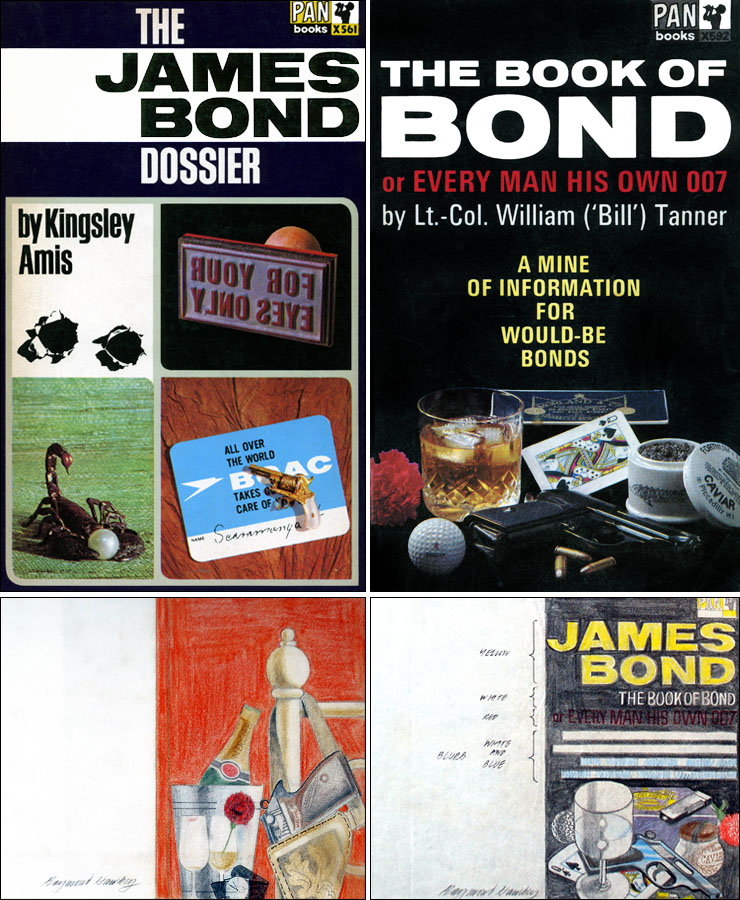 |
||||
|
Following the disappointing critical reception of Ian Fleming's 1962 novel THE SPY WHO LOVED ME, the author requested that there were no reprints or paperback editions of the book. Although a paperback edition was published in the United States by the New American Library under their Signet imprint, it was not until three years after Ian Fleming's death that his estate finally relented and allowed PAN to issue a paperback for the British market, and this was first published on May 12, 1967. Also published that day was the first UK paperback edition of THE MAN WITH THE GOLDEN GUN, film tie-in editions of CASINO ROYALE and YOU ONLY LIVE TWICE, and The James Bond Dossier by Kingsley Amis. |
||||
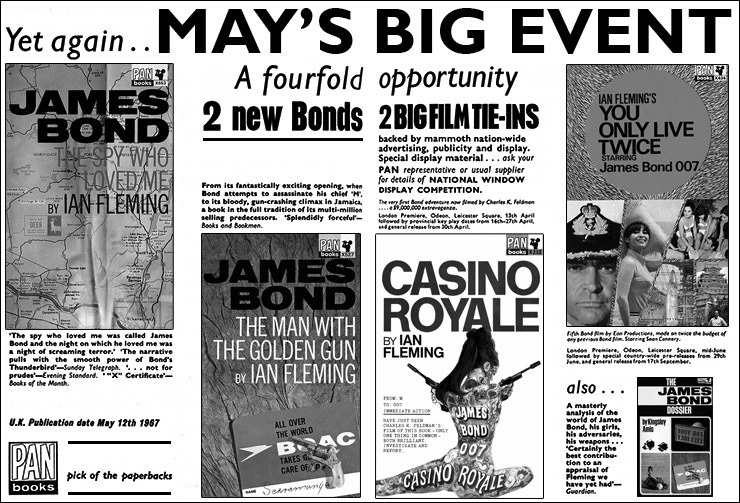 |
||||
|
The initial print-run of 450,000 copies of THE SPY WHO LOVED ME sold out very quickly and a second printing appeared in 1968. Later print-runs were very small and it is the first printing which is still very easy to obtain. The initial interest in the paperback didn't sustain, and sales in future years declined to an all-time low in 1976 when the remaining 500 copies were sold. THE SPY WHO LOVED ME sold 807,500 copies in total eventually going out-of-print in 1977. Although it was reprinted as part of the ‘white-model’ and ‘still-life’ series it remains the only Ian Fleming novel published in paperback by PAN Books which didn't sell over a million copies during its 10 years in circulation. When it came time for a film tie-in Fleming's story was ignored and Christopher Wood's JAMES BOND, THE SPY WHO LOVED ME that was published in its place in paperback by Triad/Panther to support the 1977 Roger Moore film version. |
||||
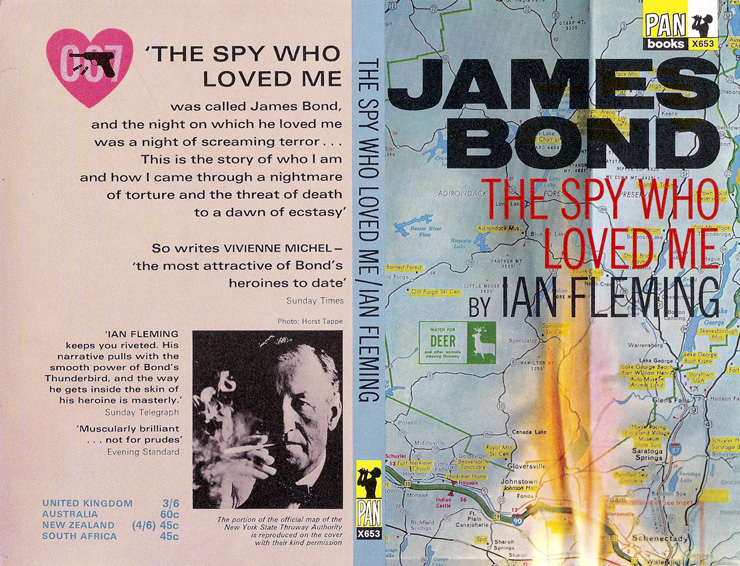 |
||||
|
Ian Fleming's second collection of short stories was finally published in paperback by PAN Books in July 1967 with the title OCTOPUSSY. The paperback also included THE LIVING DAYLIGHTS and added THE PROPERTY OF A LADY, which was the first time this short story had been widely available in the UK following its original appearance in the post-auction catalogue The Ivory Hammer: The Year at Sotheby’s in 1962. The first two printings were exported overseas and sold 76,000 copies. OCTOPUSSY was then available in the UK from the third printing which was published on June 7, 1968. 270,000 copies of the third edition were printed, with an additional 50,000 three weeks later. Although overall sales dropped in the following years, OCTOPUSSY was still the highest selling James Bond paperback title that year with a respectable 362,000 copies, but this fell to only 34,000 the following year. By the end of 1977 when PAN lost the paperback publishing rights, OCTOPUSSY had sold 613,000 copies making it the least successful of all of PAN's Bond titles. The Jonathan Cape hardback edition (under the title OCTOPUSSY AND THE LIVING DAYLIGHTS) had been published in June 1966 and never sold out its print-run of 50,000 copies, which were eventually re-priced to sell off the remaining stock in the 1970s. This is therefore the only Ian Fleming title in hardback which exists solely in the first edition. Unscrupulous sellers in more recent years have inflated the price, pointing out the book is a ‘first edition’, when there was never a second. |
||||
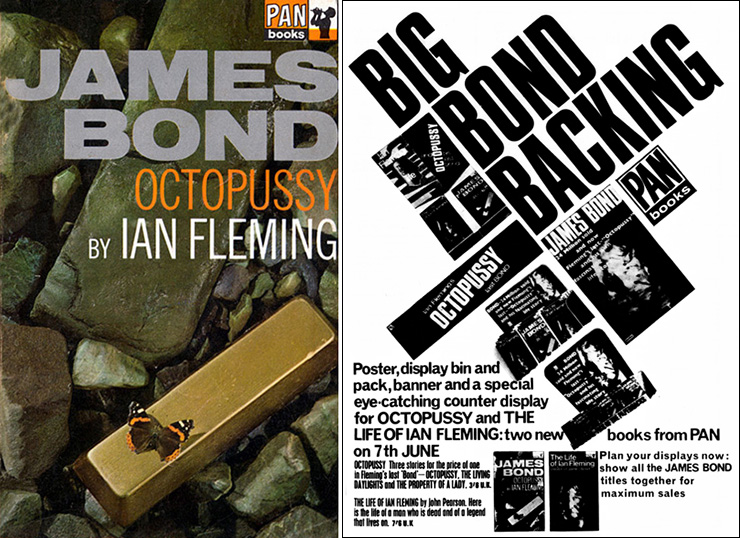 |
||||
|
Also published by PAN Books on June 7, 1968, was John Pearson's ground-breaking biography The Life of Ian Fleming, which was cross-promoted by PAN Books on posters featuring the clever dust-jacket art designed by Jan Pienkowski (1936-2022) that also appeared on the 1966 Jonathan Cape hardback edition. PAN Books were also keen to point out that Ian Fleming's James Bond novels had now sold 24-million copies in paperback. |
||||
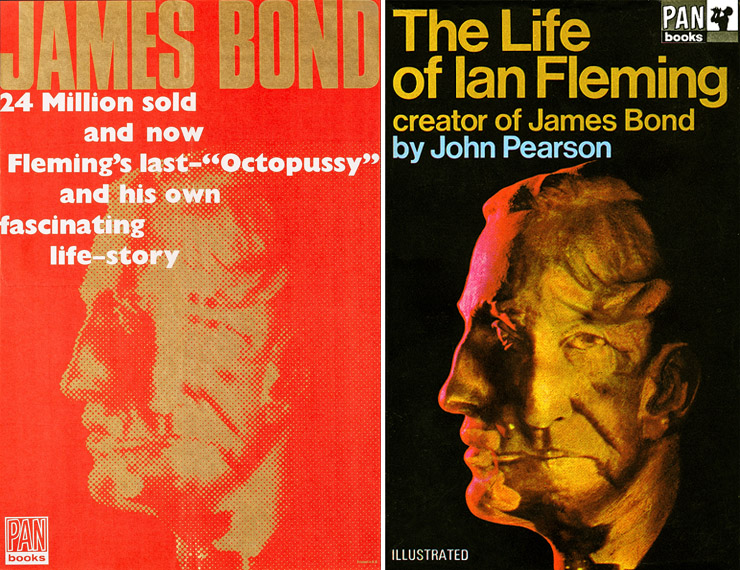 |
||||
|
Although this is the first and only series of PAN paperbacks with a uniform set of covers, the titles were not released in the same order as Ian Fleming's novels were originally published, so it was not until July 1968 when a complete set was finally available. Copies in good condition are still relatively easy to obtain on the second-hand market. As the Raymond Hawkey series sold in such huge numbers, and their circulation coincided with the release of the Sean Connery films, the covers became ubiquitous and were the most widely-read editions of any of the James Bond novels in paperback. |
||||
|
||||
|
Utilising two modern sans-serif fonts (Helvetica and News Gothic) and a simple effective graphic image, Raymond Hawkey's redesign played an important part in transforming the sales of the James Bond novels in the early 1960s. It was Raymond Hawkey's idea of putting ‘JAMES BOND’ above the title and author on the front cover that revolutionised the paperback market in the UK, and the concept was copied by other publishers in subsequent years. PAN issued most of the Bond novels again from 1969 with new photographic covers, but retained Hawkey's effective typography as the key eye-catching device at the bookstand. In 1969 Raymond Hawkey designed the title sequence for Richard Attenborough's Oh! What A Lovely War, which was co-produced and written by an uncredited Len Deighton, and THUNDERBALL cover photographer Brian Duffy. In later life Raymond Hawkey became a well-respected author in his own right and also devised the cover artwork for his 1974 debut novel Wild Card, co-authored with Roger Bingham and published in hardback by Jonathan Cape. The dust jacket of Wild Card defied convention once again by just featuring a large red exclamation mark, with no mention of the author or title! Encouraged by his friend Len Deighton, Hawkey penned three more thrillers - Side-Effect (1979), it (1983) and End Stage (1988), also writing and co-designing a 3D pop-up book Evolution: The Story of the Origins of Humankind, published by Putnam in 1987. Raymond Hawkey died in 2010 aged 80. |
||||
|
||||